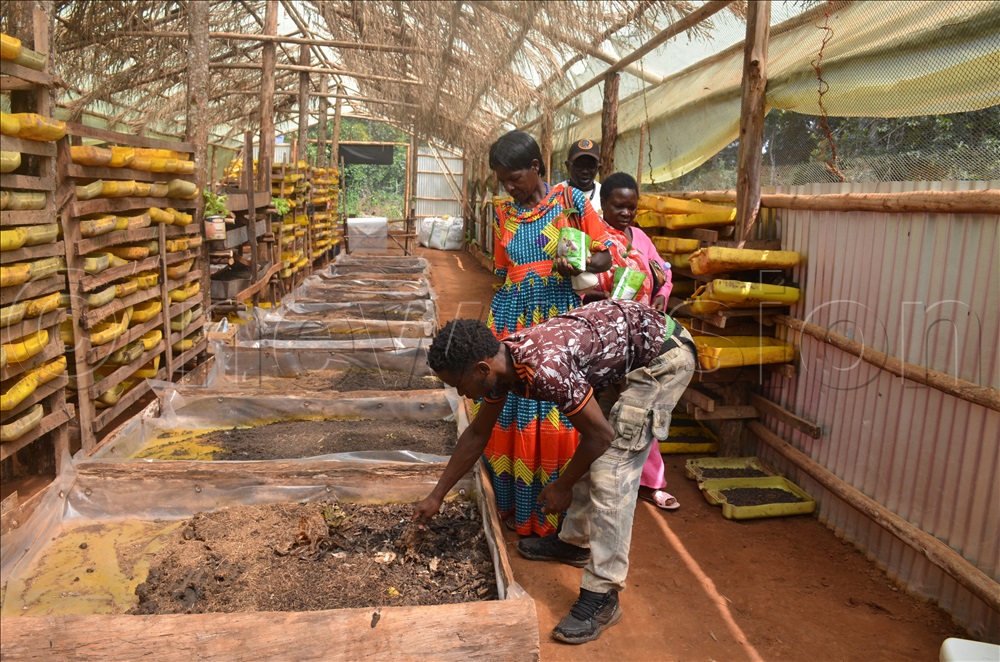By Samuel Nkuba
The Black Soldier Fly Larvae farmers in Kalangala district are reaping big from this investment after diversifying to livestock farming and horticulture.
In 2022, Lagu Farms introduced Black Soldier Fly Larvae farming in Kalangala district where 20 groups were enrolled into this new venture, however, many termed it a disgusting job.
For those who embraced the new farming method, training was held on how best they could gain from the larvae, they were also given startup capital in the form of materials used in rearing, eggs, and were availed with decanter being their main food.
Today, this model of farming is employing 131 families in different villages of Kalangala which include; Kagulube, Lusozi, Maboga, Kizira, Bumangi, Kyabwima in Mugoye sub-county, Mwena, Kalangala in Kalangala Town Council and Buyoga – Bujumba, Buswa, Bweza, Dajje in Bujumba sub-county.
Starting other ventures
Josephine Nsanji Sekitoleko from Buyoga narrates that from rearing the larvae, different members mainly women have been able to set up other projects such as livestock including; chickens and ducks.

“Our concentration was only on Black Soldier Fly Larvae, but as we consistently harvested, we were advised to invest into livestock where to date, we have multi-purpose farms,” says Sekitolekoe.
Suzan Nakachwa, another farmer, told New Vision that besides chicken, she is also engaged in a piggery project which she started after selling off her chicken.
“Many of our colleagues abandoned this new model of farming, referring to it as a disgusting job, however, being persistent we started new projects which we do jointly to earn a living,” she says.
On average, a farmer can harvest 5kgs of larvae from a 1g larvae egg investment. This implies that for sh2,000 per kg, a farmer earns sh10,000 a week.
With the combination of poultry, they can earn between sh100,000 to sh200,000 given the number of birds on their farms.
Imelida Nakiwala Kafumbire, a farmer said that with this monthly income, women mainly widows and teenage mothers can sustain their families with or without help from their spouses.
The leftovers of larvae feed act as manure for different crops. Farmers use them in their small-scale banana plantations thus getting more yields.
Why larvae farming?
With its protein component, the insect (larvae) acts as food for chicken, also used in making pellets while its powder makes good porridge for human consumption.
Jackson Baguma, the Kalangala District Production Officer narrates that if the production of larvae increases to satisfy the production of animal feeds, the pressure imposed on the lake leading to overfishing of silverfish will decrease since the available catches will only be for human consumption.
“Also, our fishing communities live on small pieces of land which hinder them from engaging in farming on a large scale but if they also embrace this new model of farming larvae, it will employ many who are jobless,” he says.
Expansion of greenhouse
After the increase in the number of farmers from 20 to 131 families, the demand for eggs increased. Initially, Ragu Farms Greenhouse had a production of 500 grams of eggs.
“We had also laid off some farmers to satisfy the few who were remaining,” says Tonny Kiggundu from Ragu Farms.
He further narrates that they resorted to lobbying for another multipurpose greenhouse where demonstration farms can be set up to incorporate the production of more eggs.
“Rotary Club of Kampala Ssese rescued our farmers when they constructed a new greenhouse. In this greenhouse we will be able to produce 1kg of eggs per week,” says Kiggundu.
Kiggundu further says that 1kg can satisfy the current number of farmers in villages of Mugoye sub-county, Kalangala Town Council and Bujumba sub-county.
At least each gram of eggs can yield 5-6kgs of mature larvae every week.
Irene Nabayunga, the former club president says that they decided to invest sh10m in the greenhouse because it’s one of their pillars as Rotary to support economic empowerment.
Moses Ssebuggwaawo, the incoming president promised to lobby for more funds in support of this project that is intended to boost the economic status of different communities in the islands.
“Farmers have requested for group greenhouses which we’re going to focus on in this Rotary year 2024/2025,” says Ssebuggwaawo.
Farmers are optimistic that if they are helped with group greenhouses, they will produce more harvests as well as boost their economic status.





